Long before 9/11, Washington regarded East Africa as a fertile playing ground for terrorists. Osama bin Laden spent half a decade in the Sudan during the 1990s, and the 1998 embassy bombings in Tanzania and Kenya highlighted the vulnerability of American targets in the region.
But anarchic Somalia, whose government collapsed in 1991, has always been Washington’s principal concern. Policymakers fear failed states, because they assume that sooner or later the security vacuum will offer a safe haven for terrorists. Somalia has been especially worrisome because of the persistent terror activity in the region, and also because of a perceived Somali hatred of America, which stems from the Black Hawk down incident of 1993, in which the bodies of American soldiers were dragged through the streets of Mogadishu. That episode is poorly understood but has nevertheless made a lingering impression in Washington.
The fear that Somalia would sooner or later provide a safe haven for al Qaeda has led the United States on a long, quixotic quest to build a government in Mogadishu. Since 2006, Washington has permitted (and bankrolled) various invasions of Somali territory designed to eliminate a series of radical Islamist threats. Of course, each of the indigenous “terror” groups that Washington has been fighting—from the Union of Islamic Courts to today’s notorious al Shabaab—was invented by Somalia’s beleaguered population as a counter-reaction to the heavy-handed Western intervention that came before. The Union of Islamic Courts, for example, came to power when Mogadishu’s population revolted against a CIA scheme that employed a group of hated Somali warlords as U.S. proxies; and al Shabaab became a national resistance movement only after Washington’s closest regional ally, Ethiopia, invaded and brutally occupied the country.
Since the emergence of al Shabaab as a national military and political force in 2007, the bulk of Washington’s counterterror funding has been directed towards an African Union peacekeeping mission (known by its acronym, AMISOM). AMISOM’s original mandate was to protect the corrupt and hopelessly incompetent government set up by Washington’s regional allies, but over the years, this mandate has evolved into a warfighting effort to degrade al Shabaab’s military capability and its vast hold on territory.
Unfortunately, the war against al Shabaab is not a battle that can be won.
In 2011, AMISOM succeeded in driving most of al Shabaab’s fighters out of Mogadishu, and shortly afterwards, a famine swept Somalia. The staggering death toll of that famine (upwards of 200 thousand dead, most of them children) was largely attributed by the Somali population to al Shabaab’s abominable practice of burning down forests and refusing humanitarian aid. Al Shabaab’s political credibility was destroyed, and AMISOM deftly seized the political opening to make a series of military advances, disrupting al Shabaab’s control over most of the towns and rural territory it had held.
Today, al Shabaab is heartily disliked by most Somalis, and it doesn’t control much territory. AMISOM has swarmed over the country, regional governments are popping up left and right, and, though the Somali prime minister is fired and replaced on an annual basis, along with most of his ministers, the national government has managed to avoid a visible collapse.
But none of these administrations are terribly interested in governing. The Somalis remain chronically underserved, politically voiceless, and—most important—unpoliced. And al Shabaab, though politically redundant, remains a potent military force. Last month, it launched its deadliest attack to date on AMISOM, killing more than 100 Kenyan soldiers who were holed up inside a military base at El Adde, near the Kenyan border. The failure of AMISOM’s allies in the Somali National Army to warn of the coming attack (the Somali soldiers seem to have left the vicinity prior to the assault and largely escaped harm), indicates that the political winds are shifting against the peacekeepers. Many Somalis appear fed up with the abuses perpetrated by AMISOM (the scandals over the years have ranged from indiscriminate civilian killings to corruption to sex abuse) and increasingly suspect that the mission is a cover for neighboring countries to pursue their own economic and territorial ambitions in Somalia.
This creates an unresolvable dilemma for Washington. At some point, Somali distaste for AMISOM—or for any foreign forces on Somali ground—will start to translate into popular support for al Shabaab or another radical offshoot. But the Somali government is still years away from being able to survive in Somalia without the protection of foreign forces. And Washington remains stubbornly opposed to the pursuit of an inclusive political settlement, which would have to include the remnants of al Shabaab and could not unreasonably privilege the government in Mogadishu.
While Washington has been preoccupied with AMISOM and the nascent Somali government, al Shabaab has spread far beyond Somalia’s borders. And again, Washington itself provided the motive for this expansion. The U.S. strategy of bankrolling regional troops to conduct the ground war in Somalia effectively regionalized the conflict: al Shabaab’s major terror strikes in Kenya and Uganda were explicitly in retaliation for those countries’ support of AMISOM. And al Shabaab has been able to set down deep roots in Kenya in the wake of its invasion of Somalia, drawing homegrown radicals from Kenya’s large populations of disenfranchised Somalis, Muslims, and youth. Stopping the spread of al Shabaab in Kenya will require Washington to tackle Kenya’s undisciplined security forces and endemic corruption—another expensive, decade-long enterprise—and the stakes are much higher in Kenya, which hosts thousands of American business, humanitarian, and diplomatic interests.
The Somalia counterterror adventure has diminished Washington’s leverage in another problem spot in East Africa: Ethiopia. Popular protests that emerged there in 2012 among the disempowered Muslim community have lately spread to the largest ethnic group in the country, the Oromo. The Ethiopian government has labeled all of these legitimate protestors “terrorists” and either killed them or thrown them in jail. As in Somalia, fears of terrorism in Ethiopia could easily become a self-fulfilling prophecy if that government’s ham-fisted tendencies are not reigned in. But Washington has sacrificed any leverage it may have had over Addis Ababa through its dependence on Ethiopian ground troops in Somalia.
The terror threat in the Horn of Africa has evolved since 2011. It has shifted dangerously from the isolated expanses of Somalia to the crowded hub of Nairobi and is likely soon to encompass other regional capitals. But Washington remains in a reactive mode, still curiously focused on stabilization and state building in Somalia. It seems indifferent to the presence of radical groups, like the Allied Democratic Forces, in the quasi-anarchic hinterlands of the Democratic Republic of Congo—but the ADF is a potential bridge between Uganda (where Washington’s erstwhile ally, Yoweri Museveni, is gearing up for his fourth decade in power) and the forces of al Shabaab. Likewise, Washington has no ability to project influence into Eritrea, an isolated country on the Red Sea that is strategically vital because it bridges the short distance between Yemen and Ethiopia.
The spread of terrorist groups across East Africa is of course not the worst scenario. So far, al Shabaab at least remains a regional rather than a continental menace, and its aims are still mostly local or national. But with terror movements on the rise in West Africa and across the Maghreb-Sahel, there is a rising risk of operational collaboration between terror groups and the possibility that their objectives will take a pan-African form, or perhaps be subsumed into the overarching jihadi narrative of al Qaeda or the Islamic State. This type of collaboration is thankfully not on the immediate horizon—but the United States urgently needs to re-evaluate its current focus on Somalia and its dependence on undemocratic strongmen, if it hopes to preempt that ultimate threat.












